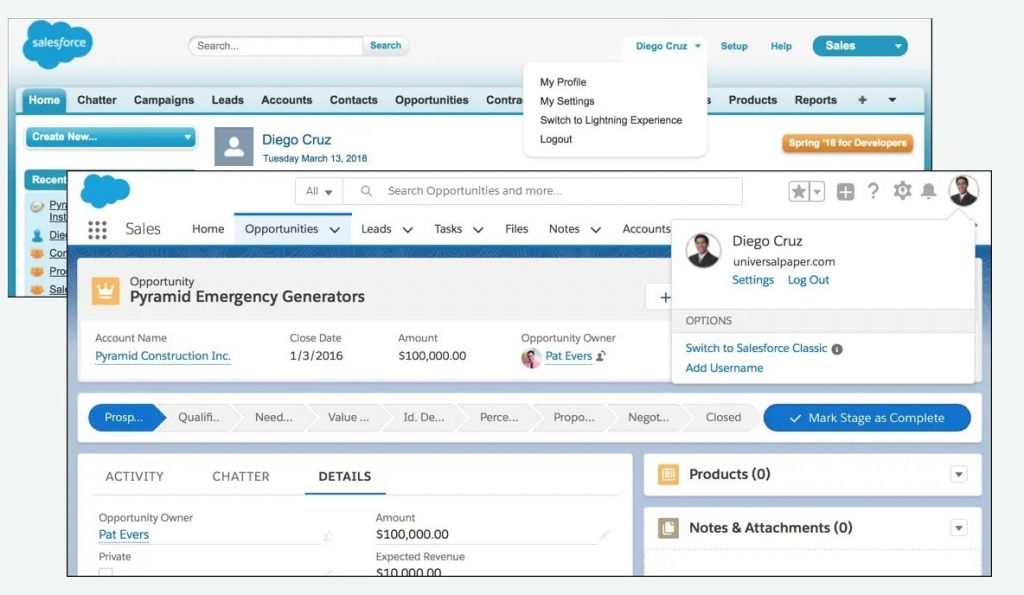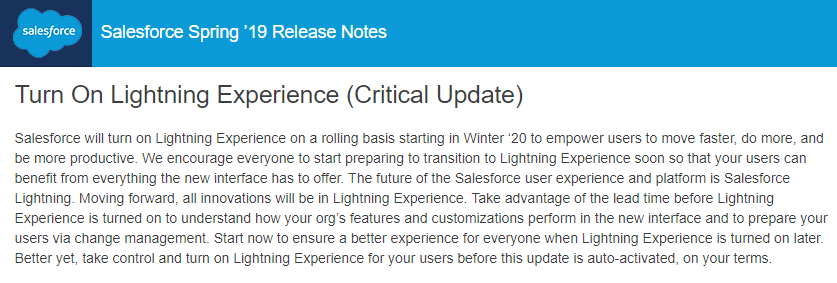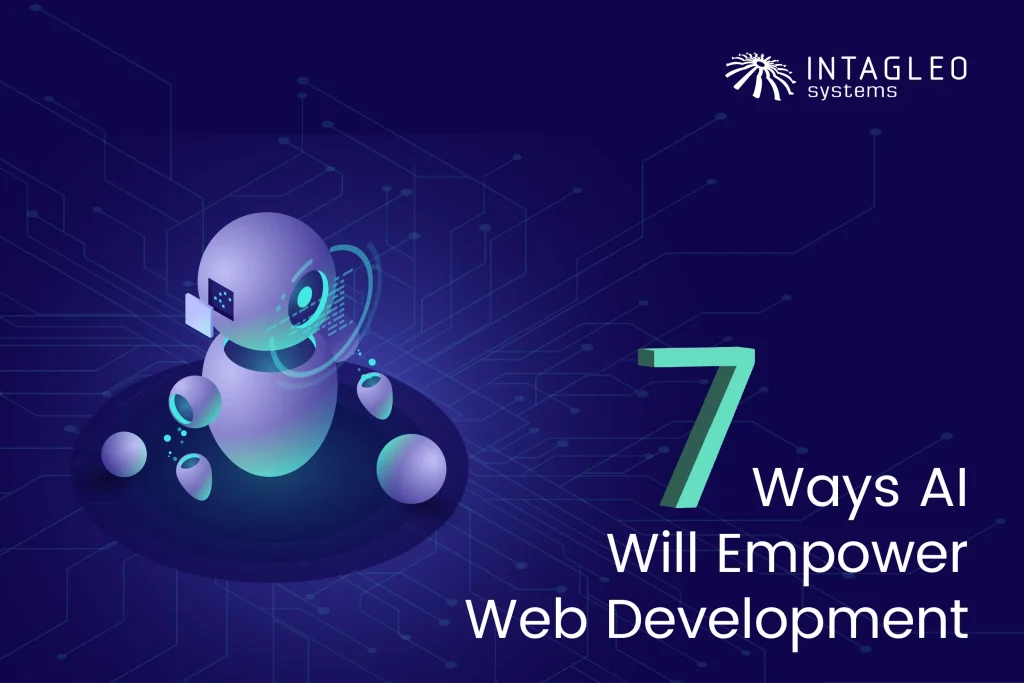Salesforce’s mission has always been to help organizations drive growth by keeping customers at the heart of their business. Hence, they’ve been continuously pushing the boundaries of their offerings by rapidly developing and incorporating new and useful features. Keeping in line with this tradition of constant innovation, Salesforce unveiled a complete overhaul of their existing Classic UI in 2015, known simply as the Salesforce Lightning Experience.
However, does this ambitious redesign live up to the hype? Is it time your organization switched over? Also, what pitfalls and consideration should you be aware of before you actually make the jump? This guide will answer all of your Lightning-related questions along with others you should be asking. Let’s begin!
What is Salesforce Lightning Experience?
The Lightning Experience is the new and improved Salesforce UI, introduced back in 2015 to slowly but surely replace the existing Salesforce Classic interface. However, it is much more than a simple reskin, and plenty is going on under the hood.
Designed to boost user productivity and ensure organizational efficiency, the Salesforce Lightning Experience makes for a robust CRM that packs a ton of features such as a smarter home page, an interactive assistant, streamlined workflows and readily accessible insights.
Comparing the Salesforce Lightning Experience and Salesforce Classic

Intended to perfectly accommodate user habits and help them get more done without breaking a sweat, Salesforce had to develop the Lightning Experience from scratch. Despite all the new bells and whistles, there were many features missing at launch and hadn’t yet made their way over from Salesforce Classic. Needless to say, many users weren’t sold on the new experience.
However, fours years and several releases later, Salesforce Lightning has more than caught up with its rapidly aging Classic counterpart and here are 5 ways in particular that it outperforms it.
Key Benefits of Salesforce Lightning over Salesforce Classic
Modern User Interface
At the heart of the Lightning Experience is Salesforce’s elegant and sleek user interface. Most notable improvements in the new Lightning design are a departure from the text-heavy newsfeed style of Salesforce Classic in favor of eye-catching and intuitive graphics and charts.
Features like contextually-aware tabs and dynamic homepage elements help users gain more visibility into the things that matter. Therefore, not only is the new interface easier on the eyes but also streamlines processes and workflows to help users work smarter.
Several elements from Salesforce’s Mobile UI have also been carried over to the new design, make it easier than ever for users to transition between the mobile and desktop interfaces.
Activity Timeline
This new addition lets users efficiently keep track of recent and upcoming activities for each account, contact, and opportunity through one, always accessible panel. It displays activities that you’ve set up or are involved in, such as various tasks and events, calls, emails, etc.
All items in the timeline are sorted according to their due dates and are accompanied by summaries and notes that provide more context. The activity timeline also allows you to filter through different activities and time ranges so you can gain better visibility into the things that matter to you and easily find what you’re looking for.
Moreover, with customizable fields and layouts, the activity timeline can be tweaked to meet the needs of all your users.
New Salesforce Assistant
Your new Salesforce Assistant resides on your home page in the Lightning Experience. It’s designed to help your sales team stay on top of all the recent updates and developments regarding different leads and opportunities.
By bringing your attention to tasks that most urgently require it, the new Assistant ensures that no lead goes cold and no opportunity slips through the cracks.
Improved Einstein AI Integration
Salesforce Einstein is designed to deliver intelligent insights and predict outcomes by leveraging different AI technologies such as machine learning, natural language processing, and image recognition. It provides up-to-date quality analytics to empower sales, marketing, and service and helps them stay on top of all their customer interactions.
While certain Einstein features are available in Classic, it’s Salesforce Lightning where the platform really gets to show off its advanced AI chops. Notable AI features exclusive to Salesforce Lightning include:
- Einstein Prediction Builder
- Einstein Strategy Builder
- Opportunity Insights
- Account Insights
- Automated Contacts
- Bot Builder
Lightning App Builder
The Lightning App Builder is a super-convenient drag-and-drop tool that makes it easy to create custom apps and user interfaces for the Salesforce Lightning Experience, without ever having to write a single line of code.
Lightning apps are composed of modular Lightning components that can be used and reused in any number of configurations to quickly develop new apps. Both the Salesforce AppExchange and Salesforce Lightning Component library currently house just shy of 300 web unique and responsive web components, that you can readily integrate into your custom app.
Salesforce Classic End-of-Life: Salesforce Will Discontinue Classic, Eventually
While there’s no definite date in sight, there’s no denying Salesforce Classic is approaching its end-of-life. This has been made evident by the fact that Salesforce has provided more Lightning-exclusive updates than Classic-exclusive ones in its recent releases, while functionality is being deprecated from Classic.
Therefore, it will be no surprise if Salesforce decides to drop support and feature updates for Classic altogether and divert all of its attention to Lightning in the near future.
Another significant development that hints at the demise of Classic can found in the Salesforce Spring ‘19 Release Notes, which indicate Lightning Experience will be enabled on a rolling basis for users as part of the Salesforce Winter ’20 Release.

Despite all the benefits of Salesforce Lightning over Classic, many admins and users are still reluctant to adopt it, and this doesn’t just boil down to personal preference. There are several vital considerations any organization should consider before making the switch. Let’s dig into them right now!
Salesforce Lightning Migration Challenges and Considerations
Planning and Implementation
While it’s perfectly safe to switch back and forth between Salesforce Lightning and Classic to get familiar with the productivity benefits of the new interface, we wouldn’t recommend diving headfirst into an organization-wide rollout.
Critical business processes are likely to get disrupted, and transitioning and training all the users in your organization can be a real pain. Moreover, the ease of migration will also depend on how extensively you’ve customized Salesforce.
It’s best to take all stakeholders into confidence when planning your implementation, so you don’t encounter any issues down the road.
Unsupported Salesforce Classic features in the Lightning Experience
Where Salesforce giveth, it also taketh away, and several Salesforce Classic users are hesitant to migrate to Lightning because of these missing features and functions.
Firstly, you can say goodbye to custom JavaScript buttons and links. However, Salesforce provides tools that let you easily convert them to Lightning-supported point-and-click quick actions.
Secondly, there are many apps on the Salesforce AppExchange that feature customizations and VisualForce pages, that don’t play well with Lightning. In this case, you’ll have to turn to Lightning-certified alternatives or wait for developers to update their apps per Salesforce Lightning guidelines.
Most of these omissions are by design, so don’t expect Salesforce to address them anytime soon. If you can’t do without them, your best bet is to juggle between Salesforce Classic and Lightning. Alternatively, you can have our Salesforce experts devise workarounds or migrate these missing features to Lightning for you.
How Much Will Switching to Salesforce Lightning Cost
While you can switch from Classic to Lightning for free, you are likely to incur some additional costs as a result of this whole ordeal. Users in your organization may require additional training for getting acquainted with the new features and user interface.
Moreover, costs may also go up depending on any additional features you might require. You may need specific Lightning components and customizations developed for carrying certain features over from Classic.
Toggling between Salesforce Lightning and Classic
Like we said it’s pretty safe to switch between Salesforce Lightning and Classic and you can do this in a pinch. In fact, doing this might help you reap the productivity benefits of Lightning along with utilizing Classic features that failed to make their way across.
Here’s how you toggle between the two interfaces:
- From Lightning Experience: Click your profile picture in the top right corner of the screen and select Switch to Salesforce Classic.
- From Salesforce Classic: Click your name and select Switch to Lightning Experience.
Do note that every time you switch to a different interface, it automatically becomes the default. Moreover, switching affects the underlying URL routing logic and can affect bookmarks and shared links. However, switching back to the original interface should fix this.
Also, this is only a short-term solution and may not work equally well for everyone. However, it can be a useful way of training employees as well as testing custom objects your organization uses before switching entirely to Lightning.
Ready to Roll-out the Lightning Experience?
While there’s no end-of-life date for Salesforce Classic in sight, it’s still clearly a matter of when (and not if) Salesforce will put it out to pasture by dropping support for it altogether. We highly recommend planning ahead and making the switch on your own terms.
You can contact us to get started today. Our Salesforce experts will work with you to chalk out a comprehensive migration strategy, ensuring total data integrity and continuity of business processes.
We will help you identify any barriers detrimental to your project’s success and propose optimal solutions to ensure you get the most out of your Salesforce Lightning Experience.


